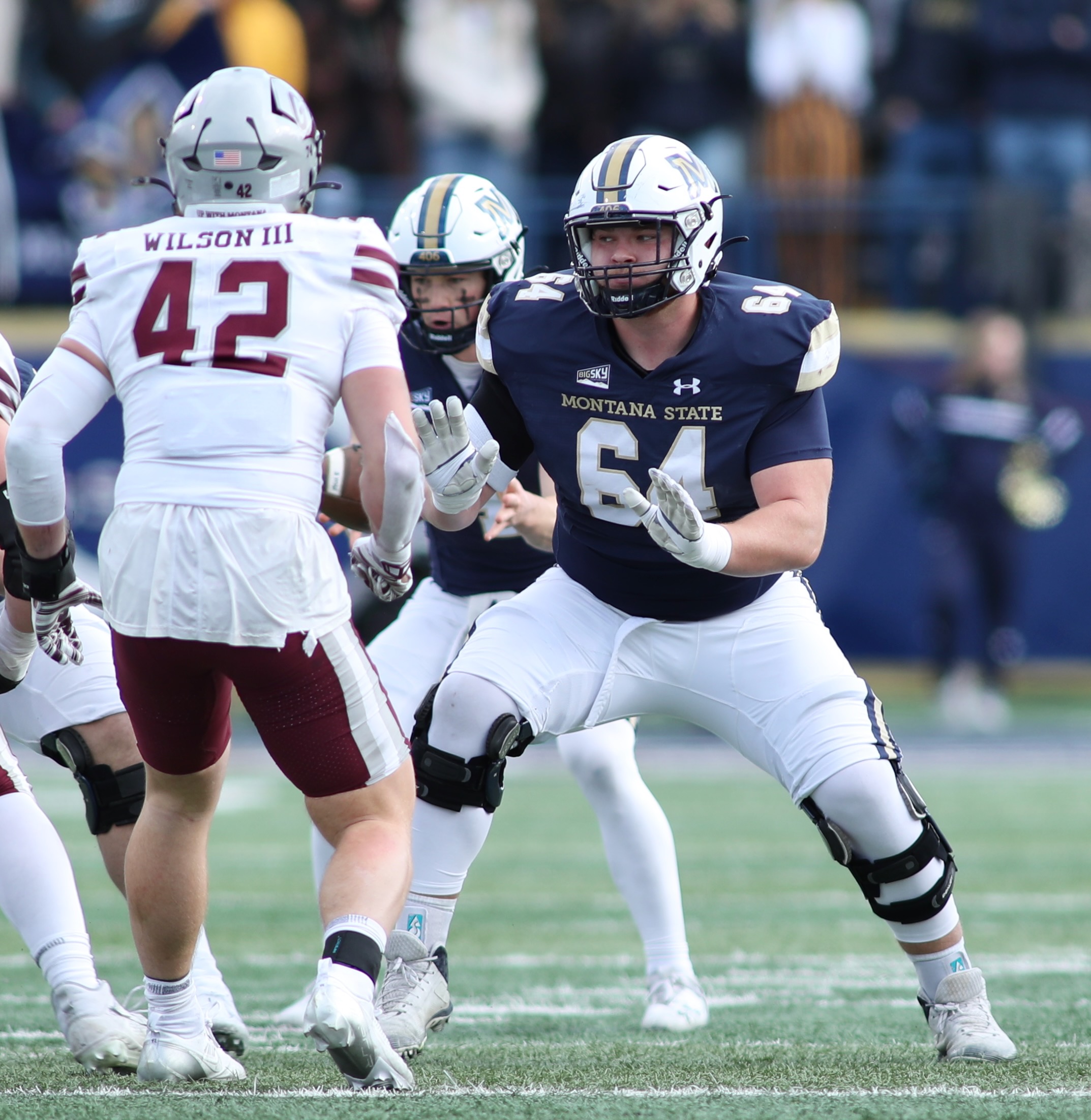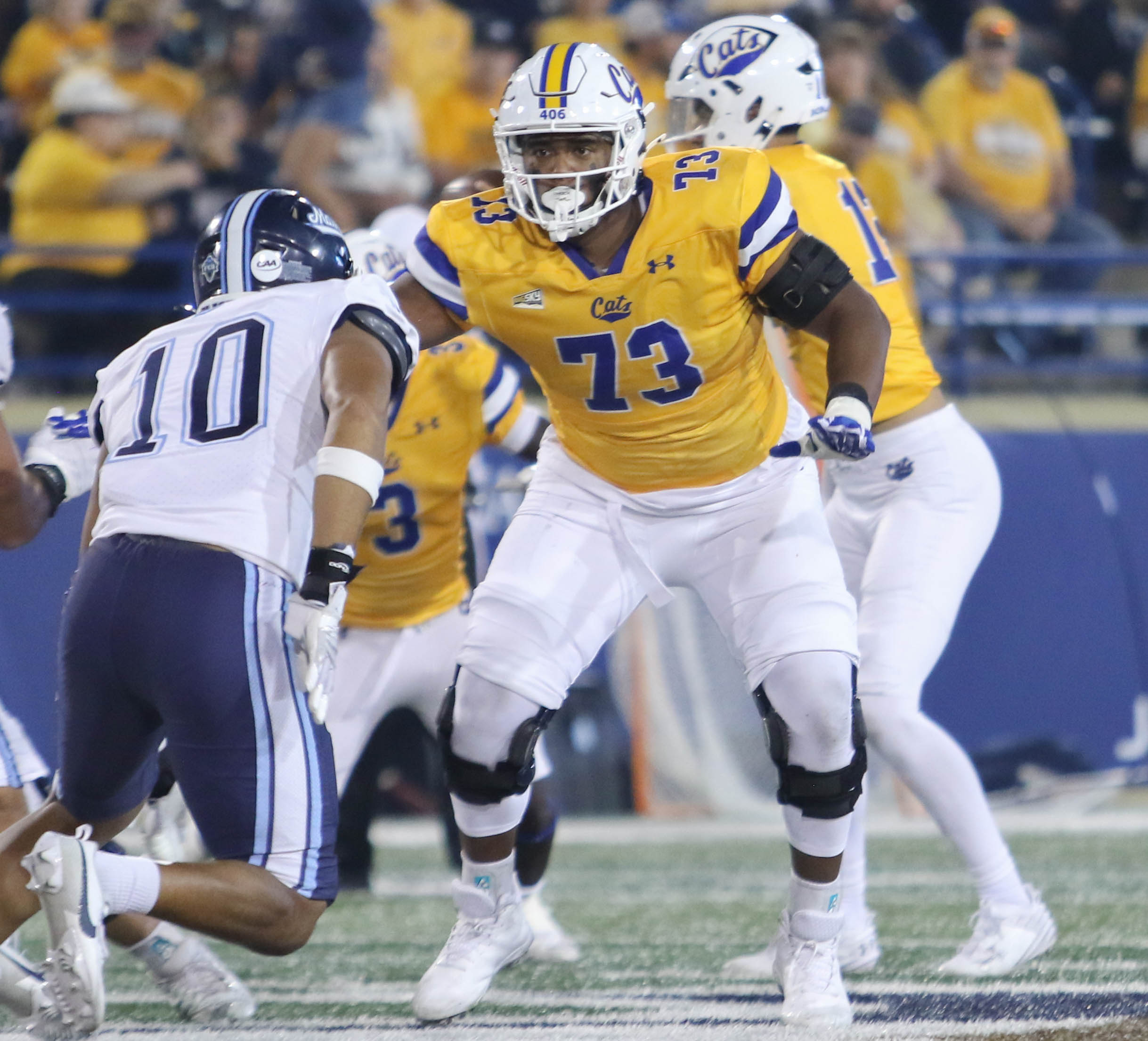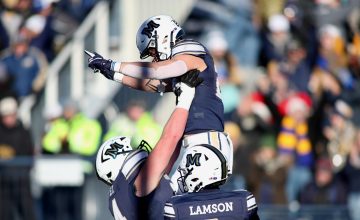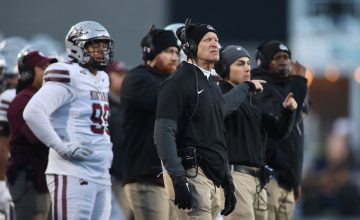This has been going on for a while now. Some would say it’s been an on-going question since the 2021 season. Others would say it’s been part of the off-season narrative at Montana State since Mitch Brott and his 50 straight starts walked out the door following the 2019 season.
Montana State finishes a season. The majority of its starting offensive linemen either graduate or transfer. And the Bobcats are expected to scramble to find players to fill the voids.
Back in 2022, just days after MSU lost in the national title game 38-10 to North Dakota State, the Bobcats were looking at just one returning player to its line. That player was freshman Justus Perkins. He was a somewhat forgotten man considering he was lined up with stars like Lewis Kidd, who went on to the NFL, senior Taylor Tuiasosopo who was a two-time all-conference selection, and eventual transfer T.J. Session (Cal).
It set visions on woebegone days when the Bobcats would have to use backup defensive linemen and tight ends just to be able to field an offensive line for spring camp. The expectations were low. Yet when head coach Brent Vigen stepped to the podium for one his first interviews during spring ball, he gave off an air of optimism. Vigen suggested that the group had a chance to be as good or better than the previous season’s unit.
What?!?
Surely this was just coach-speak. Vigen didn’t seriously believe that the Bobcats weren’t going to miss a beat. Joining Perkins, a 6-foot former walk-on, would be three freshmen and one sophomore. On its face that’s not something that would convince anyone that Vigen was on the up-and-up. Those four guys joining Perkins? Marcus Wehr, Cole Sain, JT Reed, and Rush Reimer.
Knowing what we know now, that’s more than adequate but in 2022 those four names were essentially nobodies. Wehr had moved over from the defensive line, Sain had played at two other schools before landing at MSU, while Reed and Reimer were freshmen.

“I think upfront, we never have to remake an O line,” Reed said. “We always reload especially after the ’21 year. Nobody thought we were gonna be good, be we came out and had the second-leading rushing team in the country.”
The unit would spearhead the greatest rushing attack, statistically, in MSU history to that point and lead the Bobcats from a Week 3 68-28 loss to Oregon State to 12 total wins, an undefeated Big Sky season & shared conference title – its first since 2012 – and a trip to the national semifinals.
Nothing quite as dramatic has occurred along the line since then. But every year has been reminiscent of a similar scenario. The Bobcats had to replace Sain and Reed, who were injured in 2023. To start that season, they still had Perkins, Reimer and Wehr. Wehr, however, suffered a season-ending injury midway through the season. Omar Aigbedion and Connor Moore would step in for Sain and Reed. Despite all that, the Bobcats were still the Big Sky’s top scoring team and also led the way in total offense and rushing offense.
The 2024 season started with question marks as well with Wehr’s condition an uncertainty due to the previous season’s injury and the need to replace Aigbedion and Reimer, who both transferred, Aigbedion to Baylor and Reimer to Cal. The Bobcats would lose Perkins in spring camp to a career-altering injury. He never started again for the ‘Cats.
That precipitated the move of Sain, who started his career with the Griz, to center from guard. Wehr moved to Sain’s guard spot, causing freshman Cedric Jefferson to takeover at left tackle. An injury to Burke Mastel forced Moore to guard and Titan Fleischmann took Moore’s tackle spot the week before the season-opener against New Mexico.
That patchwork unit, playing on the road against an FBS school, went on to amass 567 yards of total offense in a dramatic come-from-behind 35-31 win.
To add to all this reshuffling, ace offensive line coach Brian Armstrong left Montana State for a Mountain West gig at Fresno State. Following last season’s national championship game run that included a school-record 15 straight wins, OL coach Al Johnson took his talents to Temple. Matt Smith, a former standout at Fresno State, is set to lead the offensive front this season for the Bobcats.
So, you’ll have to excuse MSU fans and the media if they aren’t second-guessing MSU’s hopes this season as they’re working to replace the All-American Wehr along with Moore, who transferred to Michigan State, and Sain, who has graduated.
The Bobcats returned Fleischmann as the only full-time starter from a year ago. But they boast part-time starters Mastel, Reed and Jefferson this fall. However, those three aren’t a lock to win any of the spots with budding youngsters Everett Carr and Braden Zimmer making noise in camp.

The on-going process of simply reloading its offensive line is a testament to MSU’s developmental program, particularly to strength coach Sean Herrin. The Bobcats have finished in the top four in four of the last five (excluding the Covid season) full seasons of FCS football. Only North Dakota State (5) and South Dakota State (4), which have renowned developmental programs themselves, have matched or outdone that. James Madison (2) is the only program that has made the semis more than once during that span and it is no longer in the FCS.
This year Fleischmann, Mastel, Reed and Carr appear to have spots locked up. The lone battle is at left tackle where Jefferson and Zimmer are in a heated battle. Jefferson was considered a lock for the position after the 2024 season when he started a handful of games and played well. Off-season shoulder surgery forced him to miss spring camp, and he spent most of the summer rehabbing. Zimmer, meanwhile, put on some weight (62 pounds!) and the athletic 6-foot-7 freshman is pushing for the starting job on the blind side.
Smith, who was was a heralded center at Fresno State, where he was on the Dave Rimington List for the best center in the FBS, knows what a good offensive lineman looks like.
“Its kind of funny because I walked into the (indoor practice) bubble my first day here and I was like ‘who’s that guy?’ because he looks the part, no doubt,” Smith said when he first saw Zimmer.
Despite not seeing him play, Smith also knows of Jefferson’s prowess.
“He worked hard this summer and got his strength back,” Smith said. “He wants to be there, and he wants to attack it. He’s very self-aware of what’s going on. He knows before I even tell him what he did wrong.”
The Bobcats have built a reputation for winning games in the trenches on offense. The resume they’ve built over the past five years speaks for itself, with a staggering five straight seasons leading the Big Sky in rushing offense and in almost all of those seasons no other teams were close. The previous two seasons (2017 and 2018) they were second in the league. MSU has led the conference in total offense and pass efficiency offense the past two seasons, along with rushing offense.

“We don’t have room to be complacent with playing for a title last year,” Reed said. “We should keep our foot on the gas and use last year as motivation.”
Smith is implementing a new word into the lexicon of his group: violence.
“You notice guys who are violent and knocking (defensive linemen) off the ball,” Smith explains. “It’s what you want. You gotta win the line of scrimmage.
“Violence solves a lot of issues. When we get in games and we can knock a guy off the ball so he can’t pick somebody up that’s an awesome job. At the end of the day, I want (head coach Brent Vigen) to be able to call a running play and know we’re gonna get at least 3-4 yards. I think it’s a mentality. I think when those guys go out there and they know they put in the work and they know their standard and they know they’re gonna be the most violent, physical offensive line group, then I think they’ll have a little more fun, too.”
The Bobcats have just one more week of preseason camp before they prepare for their first game of the season in Eugene, Ore. against the FBS No. 7 Oregon Ducks of the Big Ten.















